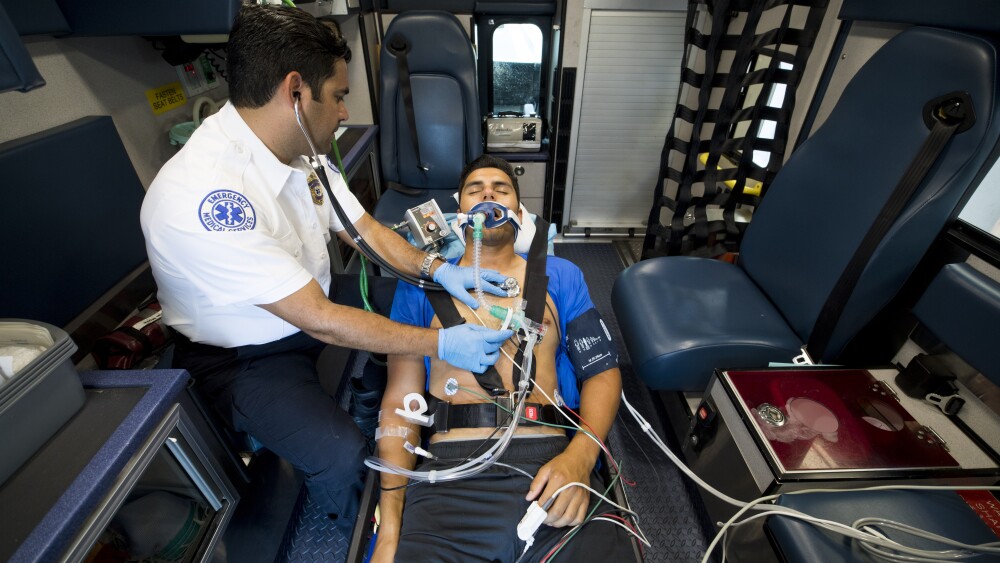Content provided by
By Eva Wild and Vanessa Kühn
Airway management and ventilation are some of the most important, yet challenging situations faced by EMS. Manual ventilation seems to be an easy task, but various studies show it is difficult, despite regular training. In extreme situations, ventilation must maintain respiratory function and ensure oxygen supply if the patient is unable to breathe on their own. Resuscitation is one extreme situation where the quality of ventilation matters and consistent ventilation can be lifesaving.1
WHY IS MANUAL VENTILATION DIFFICULT?
“In only 3 out of 106 cases all guideline-relevant ventilation parameters were met with bag-valve mask ventilation during CPR.”2
Bag-valve mask ventilation is a method that is frequently used because it is supposedly easy to do, fast and lightweight. It involves attaching a resuscitator, which is usually connected to an oxygen source, to a face mask. The mask is held on the patient’s face, covering both nose and mouth. At the same time, the resuscitator is squeezed, causing oxygen to flow through the patient’s airways. The valve prevents the oxygen flowing back into the resuscitator.
Free airways, an adequately sealed mask and the correct technique are key for this procedure. Two first responders are normally required. In actual fact, this method is not easy to implement, and studies show that even experienced EMS providers have difficulties with it.2
Most important, it lacks a reliable method for measuring the ventilation volume or pressure exerted on the airways. The delivery of oxygen by squeezing the resuscitator can only be controlled to a limited extent. Without real-time feedback, there is a high risk of excessive ventilation volumes or dangerous pressure peaks that can cause damage to the lungs.
A further problem with bag-valve mask ventilation can be an excessive ventilation rate with too many breaths per minute. This hyperventilation may have negative effects on the patient’s circulatory condition.3
ADVANTAGES OF VENTILATORS
Mechanical ventilation offers a number of advantages in direct comparison with bag-valve mask ventilation. Studies show mechanical ventilation leads to a better ventilatory status in terms of arterial blood gases and hemodynamic parameters of the patient even when transport times are short.4,5
Ventilators are also advantageous when it comes to crew resource management (CRM). Usually, two EMS providers are required for effective bag-valve mask ventilation. Ideally, one person should attach the mask to the patient’s face and hold it in place, while the other person carries out the actual ventilation. However, this ties two EMS providers to one task.
“Using a ventilator, EMS providers can complete more tasks, document them more fully and provide the patient with better care.”6
In contrast, the advantage of ventilators is that EMS providers are freed up to perform other tasks and document the emergency, so the patient can be given better and more effective care.6 This reduces the manual work required and allows medical staff to concentrate on the cause of the emergency.
At first glance, the equipment for bag-valve mask ventilation looks more compact and lighter to carry, but ventilators can also be lightweight and portable. In addition, they are easy to operate, and their functionality is less dependent on the EMS provider’s precise technique than is often the case with bag-valve mask ventilation.
WHAT IS NOW THE BEST WAY TO VENTILATE?
Coming back to the original question, from our perspective a BVM is essential and will continue to have its place, at least as a back-up device. However, out-of-hospital mechanical ventilation should be established in EMS as early as possible to maximize patient safety and guarantee the best and most consistent treatment, even when transport times are short.
REFERENCES
1. “Bag-valve-mask ventilation and survival from out-of-hospital cardiac arrest: a multicenter study.” Ahamed H. Idris, Elisabete Aramendi Ecenarro, Brian Leroux, et al. Circulation. December 2023. https://pubmed.ncbi.nlm.nih.gov/37952192/
2. “Ventilation in simulated out-of-hospital cardiac arrest resuscitation rarely meets guidelines.” Matthew R. Neth, Justin L. Benoit, Uwe Stolz, Jason McMullan. Prehospital Emergency Care. Sept–Oct 2021. https://pubmed.ncbi.nlm.nih.gov/33021857/
3. “Hyperventilation-induced hypotension during cardiopulmonary resuscitation.” Tom Aufderheide, Gardar Sigurdsson, Ronald G. Pirrallo, et al. Circulation. April 2004. https://pubmed.ncbi.nlm.nih.gov/15066941/
4. “Ventilatory improvement with mechanical ventilator versus bag in non-traumatic out-of-hospital cardiac arrest.” Alberto Hernández-Tejedor, Vanesa González Puebla, Ervigio Corral Torres, et al. Resuscitation. November 2023. https://pubmed.ncbi.nlm.nih.gov/37709164/
5. “Comparison of hemodynamic consequences of hand ventilation versus machine ventilation for transportation of post-operative pediatric cardiac patients.” Ankit Chauhan, Venuthurupalli S.P. Rajesh, Jigisha Pujara, et al. https://pubmed.ncbi.nlm.nih.gov/37706381/
6. “Automatic transport ventilator versus bag valve in the EMS setting: a prospective, randomized trial.” Steven J. Weiss, Amy A. Ernst, Ray Jones, et al. Southern Medical Journal. October 2005. https://pubmed.ncbi.nlm.nih.gov/16295811/












